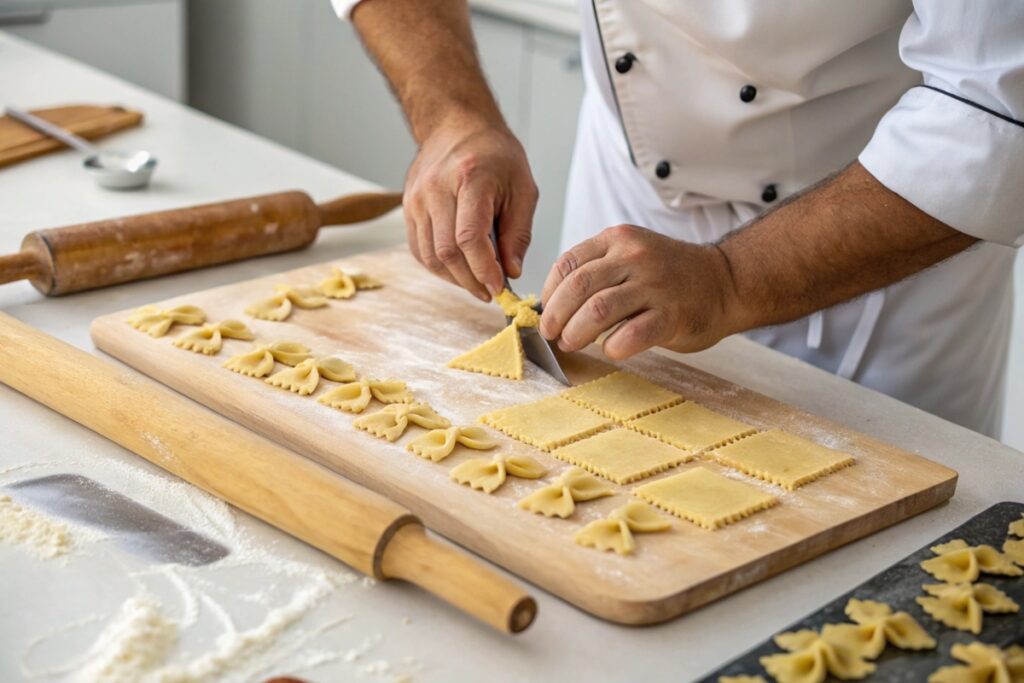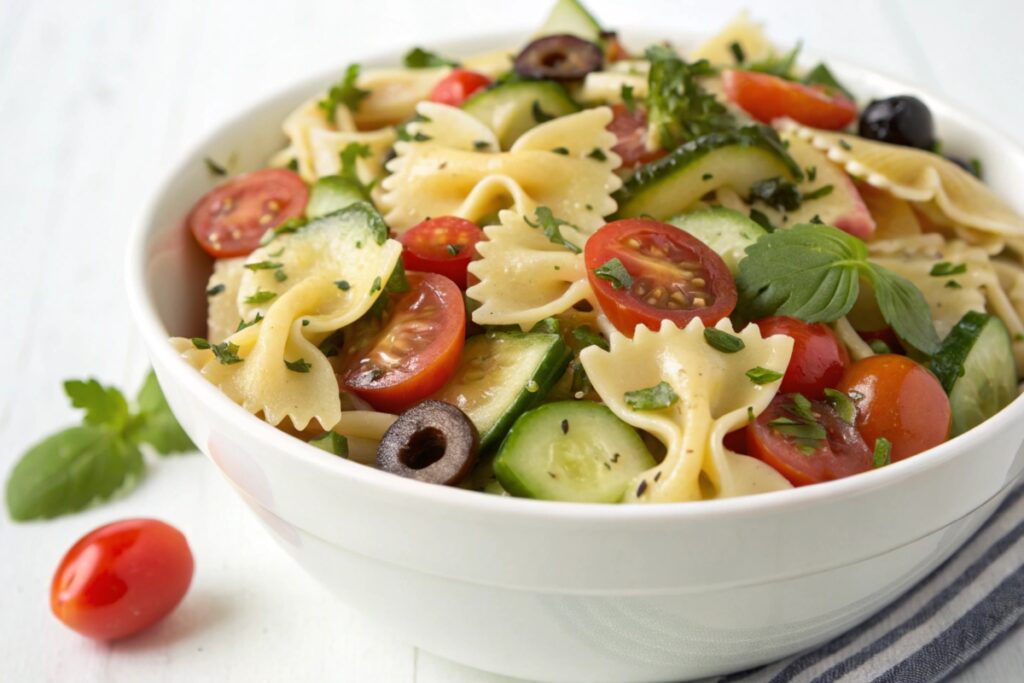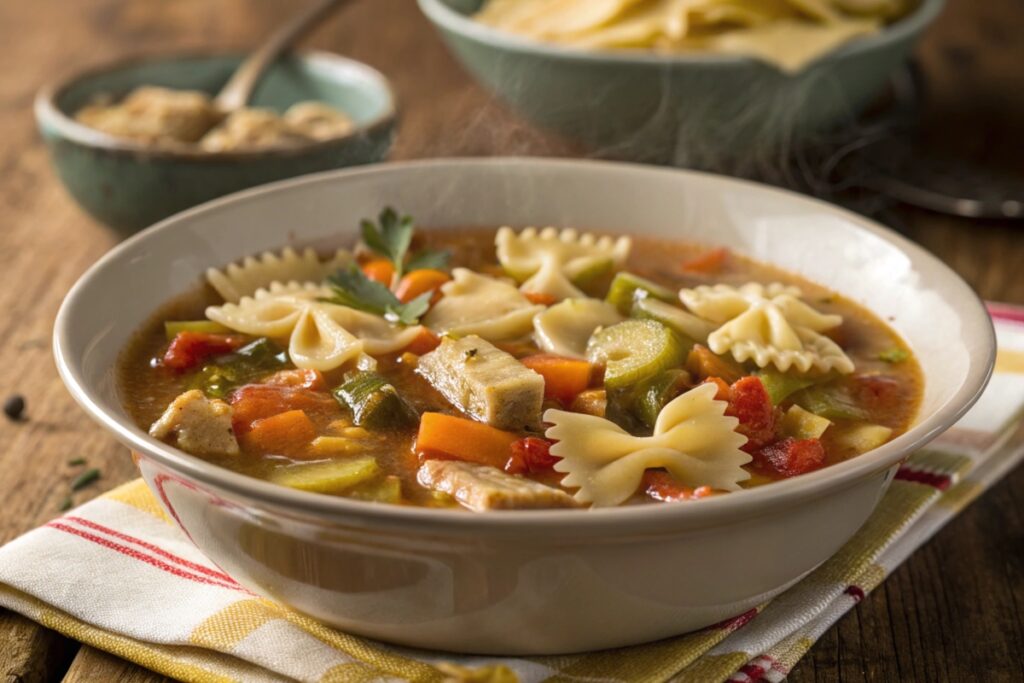What are bow tie noodles made of? It’s a question many pasta lovers have, and the answer is simpler than you might think. These delightful noodles, also known as farfalle, are crafted from just a few ingredients—typically semolina flour and water. First, they’re incredibly easy to prepare, making them a favorite for quick, wholesome meals. Next, they’re versatile enough to pair with creamy sauces, fresh vegetables, or even hearty soups. Also, their fun shape adds a playful touch to any dish, making them a hit with kids and adults alike. Bow tie noodles aren’t just delicious; they’re a must-try for anyone who loves experimenting in the kitchen. Whether you’re a seasoned cook or a beginner, you’ll enjoy discovering how these noodles can transform your meals. Ready to dive in? Keep reading to learn more about their ingredients, crafting process, and the endless ways to enjoy them.
Table of contents
Ingredients Behind Bow Tie Noodles
The Role of Semolina Flour in Pasta
Semolina flour is the star ingredient in bow tie noodles, giving them their signature texture and taste. First, it’s made from durum wheat, which is known for its high protein content. This protein makes the noodles firm and perfect for holding sauces. Also, semolina’s coarse texture helps the dough stick together during shaping. In addition, its rich golden color adds visual appeal to the noodles. Without semolina flour, bow tie pasta wouldn’t have the same bite or flavor. So, when you’re asking, “What are bow tie noodles made of?” remember that semolina flour is the key to their delicious foundation. It’s like the secret sauce of pasta making, only in flour form. With just a few additional ingredients, semolina transforms into the delightful bow ties we love.
How Water and Flour Combine to Create Bow Tie Noodles
Water and flour are the perfect pair when it comes to creating bow tie noodles. First, water activates the proteins in semolina flour, forming a stretchy dough. Then, it binds the ingredients, giving the pasta its structure. This simple combination creates the base for the unique bow tie shape. Also, the amount of water used is crucial—too much, and the dough gets sticky; too little, and it crumbles. In addition, this pairing makes pasta accessible and easy to make, even at home. When considering “What are bow tie noodles made of?” it’s amazing to think that such a simple mix results in such versatile pasta. With the right balance, this duo creates a dough that’s ready for shaping into delicious bow ties.
Traditional Recipes for Bow Tie Noodle Dough
Classic Italian Techniques for Making Pasta
Classic Italian methods bring bow tie noodle dough to life with time-honored precision. First, Italians often start by making a well in the center of semolina flour. Then, they gradually add water, mixing carefully to create a smooth dough. This technique ensures every part of the dough is perfectly hydrated. Also, kneading the dough by hand is key to achieving the right elasticity. In addition, Italians let the dough rest, which helps it roll out evenly. These techniques highlight the simplicity and beauty of traditional pasta-making. If you’ve ever asked, “What are bow tie noodles made of?” you’ll love how these methods celebrate their humble ingredients.
Variations in Recipes Across Regions
Bow tie noodle recipes vary across regions, offering unique twists on the classic dough. First, some areas add eggs to the mixture for a richer taste and softer texture. Others incorporate olive oil for added smoothness and flavor. Also, regions with specific dietary needs often use alternative flours, like rice or chickpea flour, for gluten-free versions. In addition, the resting time and kneading styles can differ, reflecting local traditions. These variations make bow tie noodles a true culinary adventure. So, when you think about “What are bow tie noodles made of?” it’s fascinating to see how diverse and adaptable their recipes can be.
How Bow Tie Noodles Get Their Unique Shape
The Hand-Crafting Process of Bow Tie Pasta
Hand-crafting bow tie pasta is an art that requires care and precision. First, the dough is rolled out into thin sheets. Then, it’s cut into small rectangles. To create the iconic bow tie shape, each rectangle is pinched in the center. This gives the pasta its distinctive look and texture. Also, hand-crafting ensures every piece is unique, adding charm to the final dish. In addition, this method highlights the craftsmanship behind traditional pasta-making. Thinking about “What are bow tie noodles made of?” it’s clear that their shape is as much about artistry as it is about ingredients. Hand-making bow ties adds a personal touch that you can taste in every bite.

Modern Machinery for Shaping Bow Tie Noodles
Modern machines have made shaping bow tie noodles faster and more consistent. First, dough sheets are fed through machines that cut and shape the pasta in seconds. Then, the noodles are dried or packed for freshness. Also, these machines mimic traditional techniques, ensuring the noodles retain their authentic texture. In addition, this process allows for large-scale production, making bow tie pasta accessible worldwide. When thinking about “What are bow tie noodles made of?” it’s fun to see how technology plays a role in bringing this classic pasta to our tables. Machines make it easier to enjoy these delightful shapes without losing their traditional charm.
Nutritional Insights into Bow Tie Noodles
Macronutrients in Traditional Bow Tie Pasta
Traditional bow tie pasta provides a balance of macronutrients for energy and satisfaction. First, it’s a great source of carbohydrates, which fuel your body. Then, it contains some protein from the semolina flour. Also, it’s low in fat, making it a lighter choice for meals. In addition, bow tie noodles can be paired with nutrient-rich toppings like vegetables or lean proteins to create a balanced dish. If you’ve ever wondered, “What are bow tie noodles made of?” knowing their nutritional value adds to their appeal. They’re a versatile option for creating delicious, wholesome meals that fit various dietary needs.

Gluten-Free and Healthier Alternatives
For those seeking healthier options, gluten-free bow tie noodles offer an excellent alternative. First, these versions use flours like rice, chickpea, or quinoa, which provide added nutrients. Then, they’re perfect for people with gluten sensitivities or those looking for variety. Also, whole-grain bow tie pasta is another option, offering more fiber and a nuttier flavor. In addition, these alternatives still maintain the classic bow tie shape, so you don’t miss out on the fun. Considering “What are bow tie noodles made of?” it’s great to know there are options for everyone to enjoy, no matter their dietary preferences.
Common Uses of Bow Tie Noodles in Cooking
Popular Dishes Featuring Bow Tie Pasta
Bow tie pasta shines in many popular dishes, adding charm and flavor to meals. First, it pairs beautifully with creamy sauces like Alfredo or tomato-based ones like marinara. Then, it’s a star in pasta salads, where its shape holds dressing and ingredients perfectly. Also, bow tie noodles are excellent in baked dishes, combining well with melted cheese and savory spices. In addition, they work beautifully in soups, adding a hearty touch to broths. When exploring “What are bow tie noodles made of?” their versatility makes them a favorite in countless recipes. They’re easy to cook, fun to eat, and endlessly adaptable.

Creative Ways to Use Bow Tie Noodles in Meals
Bow tie noodles open the door to endless creativity in the kitchen. First, try tossing them with sautéed vegetables for a quick, healthy dinner. Then, use them as a base for casseroles or baked dishes. Also, they’re perfect for making kid-friendly meals like cheesy pasta or fun stir-fries. In addition, you can experiment with global flavors, like adding them to a spicy curry or an Asian-inspired dish. Thinking about “What are bow tie noodles made of?” shows how such simple ingredients can inspire exciting, flavorful creations. With bow tie pasta, every meal can feel like a little culinary adventure!
Frequently Asked Questions (FAQs)
What kind of pasta is Bowtie?
Bowtie pasta, also called farfalle, is a fun and versatile pasta shape. It’s made from a simple dough of semolina flour and water. Its distinctive bow-tie shape is created by pinching small rectangles of dough in the middle. This shape isn’t just cute; it’s practical too! The pinched center holds sauces beautifully, while the flat edges give a satisfying bite. Bowtie pasta works well in creamy dishes, pasta salads, or even soups. When wondering, “What are bow tie noodles made of?” you can see how this simple combination of ingredients turns into something both delicious and unique!
What are Chinese bow ties made of?
Chinese bow ties are a delightful fried pastry, not pasta, with a sweet and crispy twist. They’re made from a dough of flour, sugar, and water, sometimes enriched with eggs. First, the dough is rolled out and cut into strips, then tied into bow shapes. Next, these bows are deep-fried until golden and crisp. Finally, they’re often sprinkled with sugar or drizzled with honey for extra sweetness. These treats are perfect for celebrations or as a snack with tea. While different from Italian pasta, they share the same playful bow-tie shape. You’ll love their light, crunchy texture!
What is the point of Bowtie pasta?
The point of bowtie pasta is its blend of style and function! Its unique shape isn’t just for looks—it holds sauces and ingredients beautifully. The pinched center creates a chewy texture, while the wide wings are perfect for catching creamy or chunky sauces. Bowtie pasta’s fun shape also makes it a hit with kids and adds flair to dishes. It’s versatile enough for warm dishes like casseroles or light salads. When asking, “What are bow tie noodles made of?” it’s clear their simple ingredients and clever design make them a favorite in kitchens worldwide.
What are ribbon noodles made of?
Ribbon noodles are long, flat pasta made from a simple mixture of flour, water, and sometimes eggs. These ingredients create a soft, pliable dough that’s easy to roll and cut into wide strips. Ribbon noodles are incredibly versatile, pairing well with hearty sauces like Bolognese or lighter options like garlic and olive oil. In addition, their broad surface absorbs sauces beautifully, making every bite flavorful. Whether dried or fresh, ribbon noodles are a staple in many cuisines. Like bowtie pasta, their simplicity shines, showing how a few ingredients can create something truly delicious!
Discovering the Versatility and Craftsmanship of Bow Tie Noodles
Bow tie noodles are a delightful blend of simplicity and creativity. Made from basic ingredients like semolina flour and water, they transform into a pasta shape that’s both functional and fun. First, their unique design holds sauces perfectly, making every bite flavorful. Then, their versatility shines as they fit effortlessly into various dishes, from creamy casseroles to fresh salads. Also, their playful shape adds a touch of joy to meals, especially for kids. Whether crafted by hand or with modern machines, bow tie noodles showcase the beauty of traditional pasta-making. If you’ve been curious about “What are bow tie noodles made of?” this journey reveals how a few simple ingredients create something truly special. Now it’s your turn to experiment, cook, and enjoy these charming noodles in your favorite recipes. With bow tie pasta, every meal feels a little more exciting and delicious!
